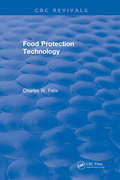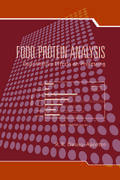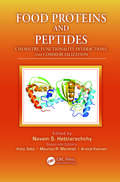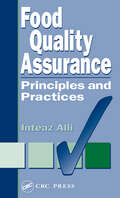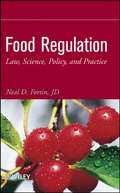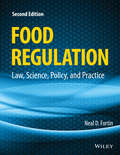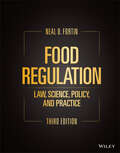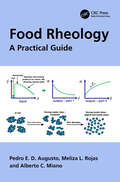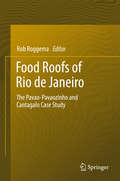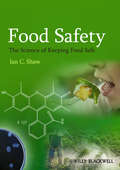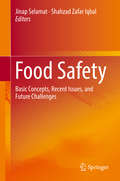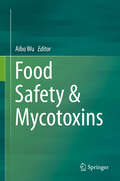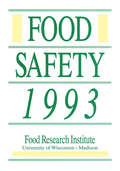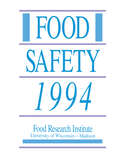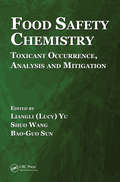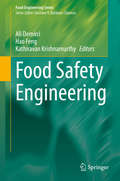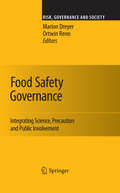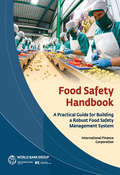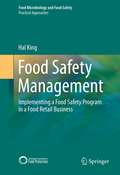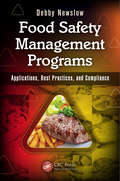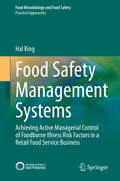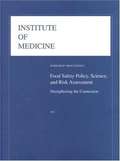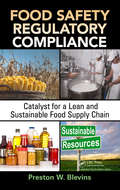- Table View
- List View
Food Protection Technology
by Charles W. FelixA reference text for US federal, state, and local environmental health officials concerned with food safety and for their US food industry counterparts presents the proceedings of the 1986 Conference for Food Protection. The text includes 36 technical papers grouped among 6 specific areasof food safety, viz.: toxicology; microbiology; good manufacturing practice regulations and guidelines, including quality control and quality assurance concepts; consumer education on food and nutrition; and the processing and packaging of new foods and new processing technologies (e.g.: genetic engineering, food-packaging interactions, irradiation processing, aseptic packaging, biotechnology). Specific recommendations by committees representing each of these 6 areas are included
Food Protein Analysis: Quantitative Effects On Processing
by Richard Owusu-ApentenIdeal for planning, performing, and interpreting food protein analyses, especially as it relates to the effect of food processing on protei investigation results. Delineates basic research principles, practices, and anticipated outcomes in each of the illustrated protein assays.
Food Proteins and Peptides: Chemistry, Functionality, Interactions, and Commercialization
by Navam S. HettiarachchyA multidisciplinary resource, this volume enables researchers to understand the physicochemical and biochemical factors that govern the functionality of food peptides and proteins. Following chapters on structure and chemistry, the book describes modes of characterization and the functional relationships of food proteins. It examines solubility and insolubility and explores proteins and peptides as emulsifying and foaming agents. Final chapters review future industrial perspectives and explore the role of nanotechnology in protein research. With contributions from a panel of international scientists, this volume captures the state of the art in protein and peptide research, providing a launching pad for further inquiry and discovery.
Food Proteins and Their Applications (Food Science And Technology Ser. #80)
by Srinivasan DamodaranReviews the physiochemical properties of the main food proteins and explores the interdependency between the structure-function relationship of specific protein classes and the processing technologies applied to given foods. The book offers solutions to current problems related to the complexity of food composition, preparation and storage, and includes such topics as foams, emulsions, gelation by macromolecules, hydrolysis, microparticles/fat replacers, protein-based edible films, and extraction procedures.
Food Quality Assurance: Principles and Practices
by Inteaz AlliThe field of food quality assurance has evolved substantially over the past decade, and certain key developments have become widely accepted. These include Quality Systems (e.g., ISO 9000) and HACCP. Consequently, it has become essential for undergraduate Food Science and Food Technology students preparing for careers in the food industry to have some basic training in these systems as part of the curricula in their university or college programs.Food Quality Assurance: Principles and Practices integrates the latest principles, practices, and terminology of food safety systems with those of quality management systems to provide an understanding of a single food quality management system. Chapters define industry terminology, review the differences and components of food quality and food safety, explain Quality Programs and Quality Systems, and thoroughly examine Good Manufacturing Practices and HACCP.Written primarily as an undergraduate-level text for Food Quality Assurance and Food Quality Management courses, the book combines the fundamentals of food safety and quality systems with the latest data from recognized international and national organizations. This is an essential guide for teaching food quality assurance to students.
Food Regulation
by Neal D. FortinFood Regulation: Law, Science, Policy, and Practice provides an in-depth discussion of the federal statutes, regulations, and regulatory agencies involved in food regulation. After an introduction to U. S. food and drug regulation, it covers current food regulations, inspection and enforcement, international law, the Internet, and ethics. While it contains detailed discussions of policies and case studies, the book is accessible to students and professionals. This is an excellent text for courses in food science, food law, etc., and a practical reference for food industry professionals, consultants, and others.
Food Regulation: Law, Science, Policy, and Practice
by Neal D. FortinFeaturing case studies and discussion questions, this textbook - with revisions addressing significant changes to US food law - offers accessible coverage appropriate to a wide audience of students and professionals. * Overviews the federal statutes, regulations, and regulatory agencies concerned with food regulation and introduces students to the case law and statutory scheme of food regulation* Focuses updated content on the 2011 FDA Food Safety Modernization Act (FSMA), the biggest change to US food law since the 1930s* Contains over 20% new material, particularly a rewritten import law chapter and revisions related to food safety regulation, health claims, and food defense* Features case studies and discussion questions about application of law, policy questions, and emerging issues
Food Regulation: Law, Science, Policy, and Practice
by Neal D. FortinFOOD REGULATION Provides both students and professionals with up-to-date coverage of US food regulatory law Food Regulation: Law, Science, Policy, and Practice presents an in-depth yet accessible account of all key aspects of United States food regulation. Using a modified casebook format, this comprehensive textbook introduces readers to the case law and statutory scheme of food regulation, defines the inspection authority and enforcement tools of various regulatory agencies, discusses current and emerging public policy issues, and more. Readers explore a wide range of topics in food law, science, policy, and practice; which connect legal theory to practical application. The third edition is fully updated to reflect significant changes in US food law, such as the regulations implementing the FDA Food Safety Modernization Act (FSMA) and the National Bioengineered Food Disclosure Standard. New case studies and discussion questions highlight important legal trends, policy debates, and application of current law. Offering thorough, highly practical coverage of food regulatory law, this authoritative volume: Features new and updated material on US food law, including recent regulations concerning novel food processing Covers requirements of food labeling, advertising and health claim guidelines, regulation of US food imports and exports, and international food law Discusses important topics such as food defense, regulation of biotechnology, ethical issues, product liability, food safety rules, and substantiation of health claims Includes a brief history of food regulation and an overview of US government agency organization and jurisdictions Contains problem exercises covering different aspects of food law designed to strengthen critical thinking Food Regulation: Law, Science, Policy, and Practice, Third Edition, remains the ideal textbook for undergraduate and graduate courses in agriculture, food science, dietetics, law, and regulatory compliance management. It is also a must-have reference for food scientists, attorneys, researchers, quality assurance and regulatory specialists, and other industry professionals responsible for complying with US food regulation.
Food Rheology: A Practical Guide
by Pedro E. Augusto Meliza L. Rojas Alberto C. MianoRheology is the study of material flow and deformation, defining different aspects of food processing and product design. Food rheology affects several unit operations during food processing, the behavior during shelf life, the consumer perception during consumption and the interaction of food products with the human body (from chewing and swallowing to digestion). Therefore, it is imperative for professionals involved in food science and engineering to understand and assess food rheology. Food Rheology: A Practical Guide presents the main aspects of food rheology as a practical guide, demonstrating that applying food rheology does not need to be a complex task. Key Features Presents a practical, direct and didactic description of food rheology, with many examples and applications Includes a guide for designing, performing and interpreting experiments, highlighting the main concerns and tips Describes different food products (liquid, semi-solid and solid; homogeneous and heterogeneous; vegetable- and animal-based) with examples and applications Explores structure-processing-properties relations More direct, practical and consulting, this book can help students, professionals and professors to understand the basic concepts to design, perform and interpret experiments related to food processing and properties.
Food Roofs of Rio de Janeiro
by Rob RoggemaOne important change in the Brazilian policies is the Pacification. In recent years the government has invested in creating safer and more livable favelas. This generally starts with creating a UPP, a police post at a central location, from where the safety is maintained. Once this has been established the PAC, the government organisation for accelerating urban development in the favelas, starts to make plans to improve the quality of life in the favela: drinking water, electricity, sewage system and other basic systems. It is essential to include the growth of food in their policies. Secondly, the discourse in urban agriculture shifts from the early stage in which every initiative is interesting, food production is a social activity and an estimated contribution to sustainability, towards the question how much food is actually produced within the city boundaries. Analyses show that the amount produced is very little. The follow-up question is how more food could be produced in the city? This is obviously also a matter of space. Current urban concepts do not offer enough space for food production and this implies new concepts need to be found. In the context of the favelas these new spaces need to be found on roofs.
Food Safety
by Ian C. ShawFood safety is a modern concept. Remarkably, it is only in the last 200 years that such concepts as foodborne germs, and the means of combating them (such as antiseptics and refrigeration), have been popularised. Yet in the 21st Century, consumers in the developed world do not accept that the food which they purchase and consume might carry a risk of making them ill - that our food should be safe is something we all take for granted.Food safety is a multi-faceted subject, using microbiology, chemistry, standards and regulations and risk management to address issues involving bacterial pathogens, chemical contaminants, natural toxicants, additive safety, allergens and more. In Food Safety: The Science of Keeping Food Safe, Professor Ian C. Shaw introduces these topics with wit and practical wisdom, providing an accessible guide to a vibrant and constantly evolving subject. Each chapter proceeds from introductory concepts and builds towards a sophisticated treatment of the topic, allowing the reader to take what knowledge is required for understanding food safety at a range of levels.Illustrated with photographs and examples throughout, this book is the ideal starting point for students and non-specialists seeking to learn about food safety issues, and an enjoyable and stylish read for those who already have an academic or professional background in the area.
Food Safety
by Jinap Selamat Shahzad Zafar IqbalThis book is designed to integrate the basic concepts of food safety with current developments and challenges in food safety and authentication. The first part describes basics of food safety, classification of food toxins, regulation and risk assessment. The second part focuses on particular toxins like mycotoxins, aromatic amines, heavy metals, pesticides, and polycyclic hydrocarbons. Recent developments and improvements in the detection of these contaminants are described. The third part deals with the authenticity and adulteration of food and food products, a topic which affects food trade on a national and international level.
Food Safety & Mycotoxins
by Aibo WuMycotoxins are increasingly attracting attention at thegovernmental, public and academic level worldwide, due to more frequent and serious contaminations of food and feedstuffs, which pose a serious threat to human health and animal production. This book reviews the latest research on mycotoxins that directly concern food safety, and especially focuses on detection technologies, risk assessment and control strategiescurrently being used in China. Gathering contributions from over 20 respected researchers, the book will benefit graduatestudents, researchers and management groups from various disciplines, including food science and technology, analytical chemistry, plant pathology, public health, etc.
Food Safety 1993
by Food Research InstituteCovers developments in food safety and foodborne illness, organizing information to provide easy access to many topics, both general and specific. Comprehensive summaries of important advances in food science, compiled from over 550 sources worldwide, are presented.
Food Safety 1994
by 0 Food Research Institute,This work covers the latest developments in food safety and foodborne illness, organizing information to provide easy access to hundreds of topics, both general and specific. Comprehensive summaries of the most important advances in food science, complied from over 580 sources worldwide, are included. Health and safety, including extensive reviews of microbiology and medical subjects, is highlighted.
Food Safety = Behavior
by Frank YiannasThis book helps in Achieving food safety success which requires going beyond traditional training, testing, and inspectional approaches to managing risks. It requires a better understanding of the human dimensions of food safety. In the field of food safety today, much is documented about specific microbes, time/temperature processes, post-process contamination, and HACCP-things often called the hard sciences. There is not much published or discussed related to human behavior-often referred to as the "soft stuff. " However, looking at foodborne disease trends over the past few decades and published regulatory out-of-compliance rates of food safety risk factors, it's clear that the soft stuff is still the hard stuff. Despite the fact that thousands of employees have been trained in food safety around the world, millions have been spent globally on food safety research, and countless inspections and tests have been performed at home and abroad, food safety remains a significant public health challenge. Why is that? Because to improve food safety, we must realize that it's more than just food science; it's the behavioral sciences, too. In fact, simply put, food safety equals behavior. This is the fundamental principle of this book. If you are trying to improve the food safety performance of a retail or food service establishment, an organization with thousands of employees, or a local community, what you are really trying to do is change people's behavior. The ability to influence human behavior is well documented in the behavioral and social sciences. However, significant contributions to the scientific literature in the field of food safety are noticeably absent. This book will help advance the science by being the first significant collection of 50 proven behavioral science techniques, and be the first to show how these techniques can be applied to enhance employee compliance with desired food safety behaviors and make food safety the social norm in any organization.
Food Safety Chemistry: Toxicant Occurrence, Analysis and Mitigation
by Liangli Lucy Yu Shuo Wang Bao-Guo SunA comprehensive examination of the chemistry of food toxicants produced during processing, formulation, and storage of food, Food Safety Chemistry: Toxicant Occurrence, Analysis and Mitigation provides the information you need to develop practical approaches to control and reduce contaminant levels in food products and food ingredients, including c
Food Safety Engineering (Food Engineering Series)
by Hao Feng Ali Demirci Kathiravan KrishnamurthyFood Safety Engineering is the first reference work to provide up-to-date coverage of the advanced technologies and strategies for the engineering of safe foods. Researchers, laboratory staff and food industry professionals with an interest in food engineering safety will find a singular source containing all of the needed information required to understand this rapidly advancing topic. The text lays a solid foundation for solving microbial food safety problems, developing advanced thermal and non-thermal technologies, designing food safety preventive control processes and sustainable operation of the food safety preventive control processes. The first section of chapters presents a comprehensive overview of food microbiology from foodborne pathogens to detection methods. The next section focuses on preventative practices, detailing all of the major manufacturing processes assuring the safety of foods including Good Manufacturing Practices (GMP), Hazard Analysis and Critical Control Points (HACCP), Hazard Analysis and Risk-Based Preventive Controls (HARPC), food traceability, and recalls. Further sections provide insights into plant layout and equipment design, and maintenance. Modeling and process design are covered in depth. Conventional and novel preventive controls for food safety include the current and emerging food processing technologies. Further sections focus on such important aspects as aseptic packaging and post-packaging technologies. With its comprehensive scope of up-to-date technologies and manufacturing processes, this is a useful and first-of-its kind text for the next generation food safety engineering professionals.
Food Safety Governance
by Ortwin Renn Marion DreyerThis book offers a detailed analysis and a set of carefully measured suggestions towards achieving greater integration of science, precaution, and public involvement in current arrangements for European food safety governance. The devised governance framework provides a distinctive system of methodologies, participatory processes, and institutional configurations that demonstrates practical advice of how complex and conflicting food safety demands might be reconciled. At the core of the suggestions for procedural reform is a design with four governance stages (framing, assessment, evaluation, management, with participation and communication as cross-cutting activities), and an organisation into four assessment and management tracks distinguishing between risk-, precaution-, concern- and prevention-based approaches. In addition, the book suggests an innovative food safety interface structure designed to improve the politics-science-society coordination throughout the governance process.
Food Safety Handbook: A Practical Guide for Building a Robust Food Safety Management System
by International Finance CorporationThe Food Safety Handbook: A Practical Guide for Building a Robust Food Safety Management System, contains detailed information on food safety systems and what large and small food industry companies can do to establish, maintain, and enhance food safety in their operations. This new edition updates the guidelines and regulations since the previous 2016 edition, drawing on best practices and the knowledge IFC has gained in supporting food business operators around the world. The Food Safety Handbook is indispensable for all food business operators -- anywhere along the food production and processing value chain -- who want to develop a new food safety system or strengthen an existing one.
Food Safety Management
by Hal KingThe goal of this book is to show how to build and manage a food safety department that is tasked with ensuring food safety within a food retail business. The experiences of the author as the head of Food and Product Safety at Chick-fil-A will be used as the model. Specifically, the book will discuss the specific components of a food safety program, the tactics needed to establish these components (forming the majority of the chapters), how to measure the success of each component, and how to influence the organization to ensure resources to support the program. The book will also focus on how to choose and work with the appropriate partners, validate the value to the business, and initiate the new component throughout the organization, including how to sustain the component within the program. Five features of this book that make it distinctive are: - Most current "How to" book on leading a food safety department from the perspective of a respected national brand - Provides the proper organization and methods to manage the work necessary to ensure food safety within the organization - Provides the means to utilize risk-based decisions linked to business practices that accommodate a business analysis model - Demonstrates step-by-step examples that can be used for continuous improvement in sustaining food safety responsibilities - Provides examples on how to gain influence and obtain resources to support food safety responsibilities
Food Safety Management Programs: Applications, Best Practices, and Compliance
by Debby NewslowThe safety of food products is fundamental. The value of an effective and well-defined, -implemented, and -maintained management system is priceless. When it is integrated into a process, it supplies the necessary foundation and structure to help provide the consumer with a safe product of the highest quality. Food Safety Management Programs: Appli
Food Safety Management Systems: Achieving Active Managerial Control of Foodborne Illness Risk Factors in a Retail Food Service Business (Food Microbiology and Food Safety)
by Hal KingThis foodborne disease outbreak prevention manual is the first of its kind for the retail food service industry. Respected public health professional Hal King helps the reader understand, design, and implement a food safety management system that will achieve Active Managerial Control in all retail food service establishments, whether as part of a multi-restaurant chain or for multi-restaurant franchisees. According to the most recently published data by the Centers for Disease Control and Prevention (CDC), retail food service establishments are the most commonly reported locations (60%) leading to foodborne disease outbreaks in the United States every year. The Food and Drug Administration (FDA) has reported that in order to effectively reduce the major foodborne illness risk factors in retail food service, a food service business should use Food Safety Management Systems (FSMS); however less than 11% of audited food service businesses in a 2018 report were found using a well-documented FSMS. Clearly, there needs to be more focus on the prevention of foodborne disease illnesses and outbreaks in retail food service establishments. The purpose of this book is to help retail food service businesses implement FSMS to achieve Active Managerial Control (AMC) of foodborne illness risk factors. It is a key resource for retail professionals at all levels of the retail food service industry, and those leaders tasked to build and manage food safety departments within these organizations.
Food Safety Policy, Science, and Risk Assessment: Workshop Proceedings
by Food ForumThe National Academies Press (NAP)--publisher for the National Academies--publishes more than 200 books a year offering the most authoritative views, definitive information, and groundbreaking recommendations on a wide range of topics in science, engineering, and health. Our books are unique in that they are authored by the nation's leading experts in every scientific field.
Food Safety Regulatory Compliance: Catalyst for a Lean and Sustainable Food Supply Chain (ISSN #47)
by Preston W. BlevinsThe global sourcing of ingredients has created complex supply chains, significant management challenges, and additional regulatory compliance requirements. This places tremendous pressure on food manufacturers, many of whom lack the knowledge, concepts, techniques, and procedures to comply with these increased requirements. Providing a roadmap for
